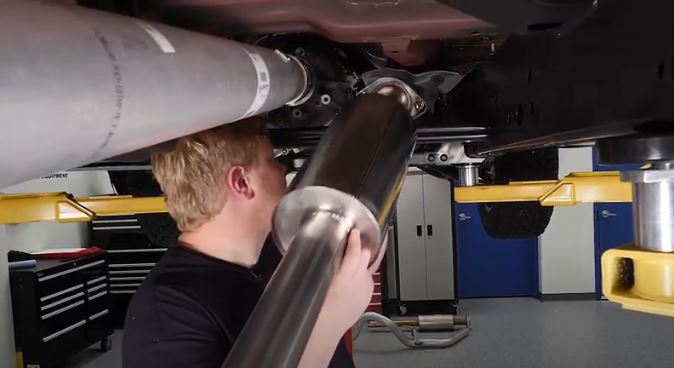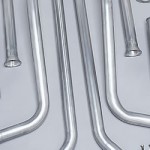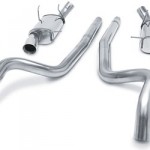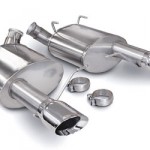A while back, we conducted a course in Exhaust Anatomy 101 to provide a beginner’s look at aftermarket exhaust systems. Now that you’ve brushed up on the basics, we’ll show you what makes an aftermarket exhaust system such a popular upgrade and provide tips on how to choose the system that’s best for your vehicle.

Exhaust Construction: Crush Bends vs. Mandrel Bends
So what makes aftermarket exhaust systems one of the most popular performance upgrades among hot rodders? Like aftermarket headers, performance exhaust systems are built differently than their stock counterparts to reduce power-robbing restriction, promote exhaust scavenging, and ultimately free up more horsepower.
The first difference between a stock and aftermarket exhaust is the diameter of the pipes. The diameter ranges available on aftermarket exhaust systems vary depending on the application. However, these systems typically come with larger diameter options to flow larger volumes of air. Again, the proper diameter size will depend on variables such as engine size, rpm, application—a Summit Racing sales rep can help you choose the right size for your specific vehicle.
The second major difference between stock and aftermarket exhaust systems is the pipe bends. Stock exhaust pipe is typically formed using a technique called crush bending. Although crush bending is a quick, easy technique, it also causes performance-robbing restrictions at the pipe bends. To eliminate these restrictions, aftermarket exhaust manufacturers use a process called mandrel bending. This process utilizes a flexible rod, which is inserted in the exhaust pipe. As the pipe is bent, this flexible rod prevents the pipe walls from collapsing or kinking. The result is consistent pipe diameter with no restrictive kinks in the bends.
Exhaust Types: Cat-Back, Axle-Back, and More
The three main types of exhaust systems are header-back, cat-back, and axle-back. Depending on what type of system you choose, aftermarket systems will come with some combination of header or intermediate pipes, crossover pipe, catalytic converter, mufflers, and tailpipes.
Header-back exhaust systems replace everything from the header collector to the tailpipes. By replacing all exhaust system components, header-back systems allow you to enlarge the diameter of your entire exhaust system to flow a greater exhaust gas volume. However, these systems tend to be more expensive and tougher to install than comparable cat-back or axle-back exhaust systems because you are replacing nearly the entire exhaust system.
Cat-back exhaust systems replace exhaust components from the catalytic converter back. These systems typically include a muffler and tailpipe, but depending on the make and model, they can also come with a mid-pipe, X-pipe, H-pipe or a Y-pipe. Cat-back systems are among the most popular exhaust upgrades for several reasons.
A cat-back exhaust system is a relatively simple modification that will free up your exhaust gas flow. The result is good “bang-for-your-buck” power gains, although the exact amount of horsepower depends on the remaining stock exhaust components and design of the catalytic converters. The freer exhaust flow can also help your engine operate more efficiently, leading to improved fuel economy. Cat-back systems also produce a more aggressive exhaust note and are typically emissions-legal because they retain the use of the stock catalytic converters.
An axle-back exhaust system includes all the components from the rear axle to exhaust tip. Although cat-back and header-back systems can deliver more power gains, there are many benefits to opting for an axle-back system. A well designed axle-back exhaust system will provide power gains over the stock exhaust but is often less expensive than comparable cat-back or header-back systems. Axle-back exhausts are easier to install and can deliver the performance exhaust sound you want.
Exhaust Configuration: Single vs. Dual Exhaust Systems
Another important consideration in picking an exhaust system is configuration. Common setups include single, dual, dual crossover, and dual exit.
The single exhaust system is the most common setup. This design features a single set of exhaust components, including a muffler with exhaust tip that typically exits behind the axle of the vehicle. Aftermarket single exhaust systems will provide a significant performance upgrade over stock thanks to larger pipe diameters and less restrictive mandrel bends. Plus, they’re usually less expensive and lighter weight than true dual-rear exhaust systems.
Dual exit exhaust systems are basically a twist on single exhausts. These systems utilize the same configuration as a single exhaust system—one headpipe, converter, and muffler—but have two exhaust tips exiting from the muffler. There is no real performance advantage to this design, but some hot rodder prefer the added performance styling of the dual tips.
True dual exhaust systems are arguably the most popular exhaust systems in the hot rodding world. This design features two separate pipes that run from the headers all the way back to the exhaust tips, along with two catalytic converters (depending on the application and system) and two mufflers with their own exhaust tips. Many performance enthusiasts prefer this design because of its sporty look, the distinctive growl of the dual mufflers, and the high-flow capabilities of two separate exhaust passages for each bank of engine cylinders.
The one main disadvantage of a dual exhaust system is potential pressure imbalance between the two sets of exhaust components. Uneven backpressure can cause one bank of engine cylinders to back up and make less horsepower than the other bank. Dual crossover systems incorporate a special “crossover” to eliminate this problem. This crossover pipe allows exhaust gases to flow freely between the two sets of pipe, balancing out the exhaust flow and eliminating excess backpressure on one side. The dual crossover exhaust system is generally regarded as the best performing exhaust but, in many cases, requires some extra modifications for proper fit.
Depending on the manufacturer, there are other less common exhaust configurations available, including single muffler dual-rear exhausts and side exit exhausts. For more information on what is offered by each manufacturer, check out our complete line of exhaust systems.
Exhaust Material: Mild Steel vs. Stainless Steel
Aftermarket exhaust systems can be made from a variety of materials; Summit Racing offers systems made with mild steel or stainless steel. The biggest advantage to a mild steel exhaust system is cost. While these systems will save you some cash, they will eventually rust or corrode. Stainless steel resists corrosion, making it the ideal exhaust system material for rainy or snowy climates.
So what about headers? What are the different types and which are best for your vehicle?
Find out by reading Header How-To: 5 Keys to Choosing the Right Headers.




[…] reaching its full power potential. In our “Exhaustive Research” post, we showed you how to choose the right exhaust system to help gain back lost […]
Hellcat swap
[…] just about your tech expertise or wrenching abilities. Many times, the most crucial step is simply selecting the right exhaust system during the purchase […]
[…] basic anatomy of an automotive exhaust system, we’ll help you get to second base by showing you how to choose the right exhaust for your […]
[…] Be sure to also check out our post talking about how to choose an aftermarket exhaust system. […]
[…] sound because they use slightly larger exhaust pipes that the stock model. That said, you need to choose your aftermarket variety carefully to ensure that it suits your car. Working with an expert ensures that you get the best […]
[…] of Exhaust System: There are two major exhaust systems – dual and single exhaust systems. You need to buy a straight-through muffler that will perfectly […]
The right fittment.
Great article, keep up the good work. I would suggest to do a post about smart boxes, sound devices, and etc. I’m seeing more and more of these devices on daily basis, given the fact that I work with cars.